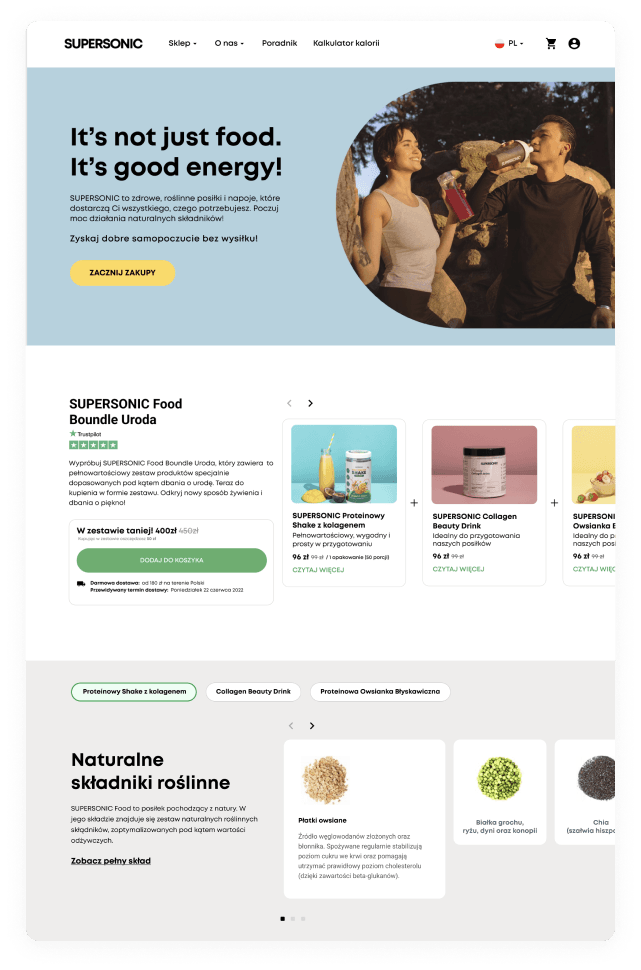

Benchmarking UX in business
Benchmarking UX is a tool that allows us to compare company, product, or to best practices and industry standards. By analyzing the competition and identifying areas for improvement, it is possible to develop a strategy that enables us to gain a competitive advantage.

UX benchmarking – what is that?
Benchmarking UX is the process of comparing and evaluating user experience (UX) between different products, services, or interfaces. It involves analyzing and comparing various aspects of UX, such as usability, efficiency, user satisfaction, and other performance indicators. UX benchmarking can help organizations improve their products or services, enhance user satisfaction, and increase competitiveness in the market.
Comparison with the competition
Benchmarking UX allows us to understand how our website or application compares to the competition in terms of user experience. This understanding can help us set goals and standards for our product.
Identification of areas for improvement
Benchmarking UX allows us to identify areas that require improvement, helping us prioritize project actions. This enables us to focus on those UX aspects that have the greatest impact on user satisfaction.
Justification of design decisions
Benchmarking UX provides concrete data that can help justify design decisions and investments in UX. This can convince both the team and stakeholders to take specific actions.
Discovering new trends
Benchmarking UX can reveal new trends and practices in the industry that can inspire innovation. This allows for continuous improvement of our product and keeping it at the forefront of innovation.
Tracking progress
Benchmarking UX helps track the progress and effectiveness of UX actions over time. It allows us to measure the effectiveness of our efforts and adjust our strategy if needed.

Supersonic Food – Food of the Future. Health food store.

Our cooperation with SUPERSONIC Food began with store optimization, and after a few months it turned into full maintenance of the e-commerce website. Thanks to our cooperation with SUPERSONIC Food, we managed to achieve results that resulted in increased sales and improved website use (User Experience).
I recommend cooperation with Codeq to everyone looking for a dedicated e-commerce partner. Their holistic approach to e-commerce development, maintenance and security was crucial to the success of our online store.
Chris Kozak Founder @ SuperSonic FoodThe benefits of UX benchmarking in business
UX benchmarking offers several benefits for businesses. Firstly, it provides a clear understanding of how a company’s user experience compares to competitors, allowing for identification of strengths and weaknesses. This knowledge helps in setting realistic goals and standards for UX improvement.
Secondly, UX benchmarking helps in identifying areas for improvement, allowing businesses to prioritize their efforts and allocate resources effectively. By focusing on the aspects of UX that have the most significant impact on user satisfaction, businesses can enhance the overall user experience and gain a competitive edge.
Furthermore, UX benchmarking enables businesses to justify design decisions and investments in UX by providing concrete data and insights. This data-driven approach helps in convincing stakeholders and teams to support UX initiatives and take necessary actions.
Additionally, UX benchmarking allows businesses to stay updated with the latest trends and practices in the industry. By continuously monitoring and comparing their UX performance with competitors, businesses can identify emerging trends and innovative approaches, which can inspire new ideas and drive innovation within their own products or services.
Overall, UX benchmarking is a valuable tool for businesses as it provides a comprehensive understanding of their UX performance, helps in identifying areas for improvement, justifies design decisions, and keeps them informed about industry trends. By leveraging the insights gained from UX benchmarking, businesses can enhance user satisfaction, drive growth, and stay ahead in the competitive market.
Types of UX benchmarking
UX benchmarking is a method used to assess and compare the user experience of different products or services. It involves measuring and evaluating various aspects of the user experience to identify strengths, weaknesses, and areas for improvement. There are several types of UX benchmarking that can be used, depending on the specific goals and requirements of the project. Here are a few common types:
1. Competitive benchmarking: This involves comparing the user experience of your product or service against that of your competitors. It helps identify areas where your product may be falling behind or excelling in comparison to others in the market.
2. Internal benchmarking: This type of benchmarking involves comparing different versions or iterations of your own product or service. It helps track improvements or regressions in the user experience over time and can be useful for evaluating the impact of design changes or updates.
3. Industry benchmarking: In this type of benchmarking, you compare your product or service against industry standards and best practices. It helps identify areas where your product may be deviating from established norms and can provide insights on how to align with industry expectations.
4. Task-based benchmarking: This approach focuses on evaluating the user experience for specific tasks or interactions within your product or service. It involves defining a set of tasks and measuring how easily and effectively users can complete them. This type of benchmarking can help identify usability issues and areas for improvement in task flows.
5. Experience-based benchmarking: This type of benchmarking focuses on measuring the overall user experience and satisfaction. It involves collecting user feedback through surveys, interviews, or other qualitative methods to understand their perceptions and emotions related to your product or service.
It’s important to choose the right type of benchmarking based on your goals and objectives. Each type provides unique insights and can help guide decision-making to enhance the user experience.
UX benchmarking process
The UX benchmarking process is a systematic approach to evaluating and comparing the user experience of different products or services. It involves several steps that help gather data, analyze findings, and make informed decisions for improving the user experience. Here’s a breakdown of the UX benchmarking process:
1. Define objectives: Clearly define the goals and objectives of the benchmarking process. Determine what aspects of the user experience you want to measure and compare.
2. Select metrics: Identify the specific metrics or criteria that will be used to evaluate the user experience. These metrics can include usability, efficiency, satisfaction, and effectiveness, among others.
3. Choose participants: Select a representative group of participants who will engage with the products or services being benchmarked. It’s important to ensure that the participants match the target user demographic.
4. Gather data: Conduct user testing or observations to collect data on the user experience. This can involve tasks, surveys, interviews, or other methods to gather both qualitative and quantitative data.
5. Analyze findings: Analyze the collected data to identify patterns, trends, and insights. Compare the performance of different products or services based on the selected metrics.
6. Identify strengths and weaknesses: Determine the strengths and weaknesses of each product or service based on the analysis. This helps identify areas for improvement and areas where a product may excel.
7. Make recommendations: Based on the findings, make recommendations for improving the user experience. These recommendations can include design changes, feature enhancements, or process improvements.
8. Implement changes: Implement the recommended changes and updates to the products or services. This can involve iterative design and development processes to continuously improve the user experience.
9. Re-evaluate: After implementing the changes, repeat the benchmarking process to assess the impact of the improvements. This helps measure progress and identify any further areas for refinement.
Benchmarking services by Codeq
Benchmarking services involve evaluating and comparing the user experience of different types of digital products or services. Here are explanations for each specific type of benchmarking service you mentioned:
1. Website UX benchmarking: This type of benchmarking focuses on evaluating and comparing the user experience of different websites. It involves assessing factors such as navigation, layout, content presentation, responsiveness, and overall usability. Website UX benchmarking helps identify areas for improvement and best practices to enhance the user experience on websites.
Example: In website UX benchmarking, you may compare the ease of finding information, the clarity of the navigation menu, the speed of page loading, and the overall user satisfaction between different websites in the same industry.
2. E-commerce UX benchmarking: E-commerce UX benchmarking specifically targets online shopping experiences. It involves evaluating and comparing the user experience of different e-commerce platforms or websites. Factors such as product search, product listings, shopping cart functionality, checkout process, and customer support are assessed. E-commerce UX benchmarking helps identify areas where the shopping experience can be improved to increase conversions and customer satisfaction.
Example: In e-commerce UX benchmarking, you may compare the ease of adding products to the cart, the clarity of product descriptions and images, the simplicity of the checkout process, and the availability of customer reviews and ratings between different e-commerce websites.
3. Apps UX benchmarking: Apps UX benchmarking focuses on evaluating and comparing the user experience of different mobile applications. It involves assessing factors such as app navigation, screen layouts, interactions, responsiveness, and overall usability. Apps UX benchmarking helps identify areas for improvement and best practices to enhance the user experience on mobile apps.
Example: In apps UX benchmarking, you may compare the intuitiveness of app navigation, the efficiency of completing tasks, the clarity of icons and labels, and the overall user satisfaction between different mobile applications in the same category.
4. Digital products UX benchmarking: Digital products UX benchmarking is a broader category that encompasses benchmarking the user experience of various digital products beyond websites, e-commerce platforms, and apps. It can include software applications, online platforms, interactive tools, or any other digital product. The focus is on evaluating and comparing the user experience to identify strengths, weaknesses, and areas for improvement.
Example: In digital products UX benchmarking, you may compare the ease of onboarding, the effectiveness of features, the clarity of error messages, and the overall user satisfaction between different digital products in the same industry.
By conducting these specific types of benchmarking, organizations can gain insights into the user experience of their digital products or services and make informed decisions to improve usability, engagement, and customer satisfaction.
Usability benchmarking
Usability benchmarking is a method used to evaluate the usability of a product or system by comparing it to a set of predefined criteria or standards. It involves measuring the performance and satisfaction of users as they interact with the product or system.
To conduct usability benchmarking, a group of representative users is selected to perform specific tasks or scenarios using the product or system. Their interactions are observed and recorded, and their performance metrics, such as completion time, error rates, and task success rates, are measured.
The benchmarking process also includes collecting subjective feedback from users through surveys or interviews to assess their satisfaction and overall user experience. This feedback helps identify areas of improvement and potential usability issues.
The collected data is then compared to established usability benchmarks or industry standards to determine how well the product or system performs. This comparison provides valuable insights into the strengths and weaknesses of the design, allowing for informed decision-making and iterative improvements.
By conducting usability benchmarking, organizations can identify usability problems early in the design process and make data-driven decisions to enhance the user experience. It helps ensure that the product or system meets the needs and expectations of its users, leading to increased user satisfaction and improved overall usability.
Benchmarking strategy – why it’s important for business?
Benchmarking strategy is the process of comparing a company’s, practices, and against those of its competitors or industry leaders. It involves identifying best practices, setting performance goals, and making improvements based on the insights gained from the benchmarking process.
Benchmarking strategy is important for businesses for several reasons:
1. Performance Improvement: Benchmarking allows businesses to identify areas where they are underperforming compared to their competitors or industry leaders. By analyzing and adopting best practices, businesses can make targeted improvements to enhance their performance and gain a competitive edge.
2. Learning from Industry Leaders: Benchmarking provides an opportunity for businesses to learn from industry leaders who have achieved success in specific areas. By studying their strategies, processes, and approaches, businesses can gain valuable insights and apply them to their own operations.
3. Identifying Opportunities and Risks: Benchmarking helps businesses identify emerging trends, market opportunities, and potential risks. By monitoring the performance of competitors and industry leaders, businesses can stay informed about market dynamics and make informed decisions to capitalize on opportunities or mitigate risks.
4. Setting Realistic Goals: Benchmarking provides a benchmark against which businesses can set realistic performance goals. By comparing their current performance to industry standards or best practices, businesses can establish targets that are achievable and aligned with market expectations.
5. Continuous Improvement: Benchmarking is a key component of a continuous improvement culture within a business. It encourages businesses to regularly assess their performance, seek opportunities for improvement, and implement changes to stay competitive and relevant.
Overall, benchmarking strategy helps businesses stay competitive, improve their performance, and adapt to changing market conditions by learning from industry leaders and identifying areas for improvement.
Trust our workflow
Great information architecture and comfortable navigation help users achieve their goals on your website. Build a website with us.
Discovery
During the discovery phase, we collect all the necessary data that allows us to make informed decisions in the following stages of the project. It helps us co-create a clear roadmap and product backlog (not sure what you mean by backlog here, maybe replace this with strategy).
Design
The UX and design phase consist of visualizing a previously developed concept. We recreate the information architecture and actualise your business goals through UX. Finally, the digital product comes to life with a specific visual style that aligns with your brand identity.
Development
Using the right tools and tech stack, everything from discovery and design is transformed into the language of technology. Every solution is complemented by extensive testing from a wide range of devices.
Support
The implementation of a digital product is only the beginning of the adventure. We offer support with maintenance and further development and are continuously present for our clients. Equipped with analytical data, we can create hypotheses and conduct A / B tests.
They trusted us
I recommend cooperation with Codeq to everyone looking for a dedicated e-commerce partner. Their holistic approach to e-commerce development, maintenance and security was crucial to the success of our online store.
Tools we use at work
Benefits of collaborating with Codeq
A 12 month warranty
The quality of work is not only empty promises. The warranty will give you assurance that our solution will be free from defects.
An experienced and well-coordinated project team
We employ the best WordPress and Shopify Developers in Poland with many years of commercial experience. We provide the highest quality of code and ongoing communication.
Efficient communication and project management
The refined and tested project management process and the continuous care of the Project Manager guarantee uninterrupted access to the status of our projects.
Technological polyglots
There are many specialists of various technologies on board our team. Thanks to them we are able to be your eyes and ears in the constantly changing world of technology.
Let’s discuss your idea!
Free consultation with an expert – maximum focus on your idea
An analysis of challenges and issues in the field of UX Design and Development
Recommendations for best practices in UX Design and Development
A comprehensive implementation plan from start to finish











